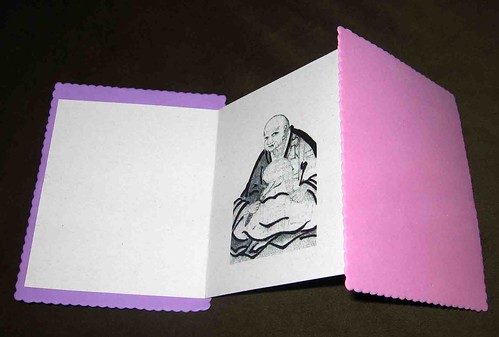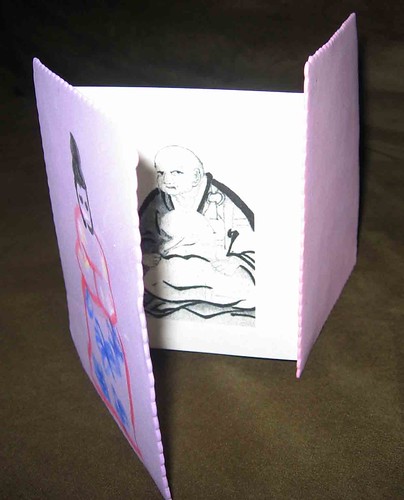I began the lesson with a little review. I figure the more times we talk a little bit about what paramitas are, the more they (and me and Jyoshin) will have an idea of the whole of the idea, rather than the simple definition. When I was looking for ideas on kshanti, I found this web page in which the author says,
If the six paramitas are aspects of Buddha nature or wakefulness, then wouldn't they--like Buddha nature or wakefulness--be always present, if obscured? And if so, wouldn't the best way to cultivate and exhibit any of the paramitas within us be to eliminate that with which we obscure it?
So I shared that idea with the girls, that the paramitas help us uncover our buddha nature. That when we express the paramitas well, we express our buddha nature. One asked what 'obscure' means, sparking a little discussion. That turned out to be a very useful dharma word.
They also remembered the paramita we have already studied, generosity, or dana. I told them kshanti means patience, but I shared with them Robert Aitken's definition from The Practice of Perfection: "Kshanti has three aspects: gentle forbearance, endurance of hardship, and acceptance of truth." They are not shy, and we had a little discussion about what 'forbearance' means. To remember what it means, 'bear' is the important part, as in "bearing up under whatever happens to you." I'm sure I will revisit this paramita, along with dana. As I look up forbearance I realize it captures kshanti better than 'patience,' because of that idea of restraint. Patience can be as simple as waiting something out, but forbearance includes the strength needed in the face of provocation.
By this time the girls were thinking of examples of patience in their lives, and how they themselves are not patient. (it's working! :) I read to them the definition from the Shambhala Dictionary of Buddhism and Zen:
Kshanti includes patience in bearing aggression and injury from other beings, in bearing adversity without being drawn away from the spiritual path, as well as patience in following difficult points of Buddhist doctrine through to comprehension
This was a useful jumping off point to share ways in which kshanti is useful in our lives. One girl listening so attentively to the lesson demonstrated kshanti. Another girl lives with a disease that necessitates her vigilance over the effect food has on her body. She needs and uses kshanti to bear this in her life. Jyoshin and I need kshanti to understand kshanti!
I did have a short story to share, one which allowed for more dialog. "Is That So" about Hakuin. When accused of being the father to the baby being carried by the girl next door, Hakuin simply says, "Is that so?" His reputation was ruined, and when the baby was born it was brought to him. He took care of it for a year. The girl finally told her parents the truth, that the father was a boy who worked in the fishmarket. The grandparents apologized deeply to Hakuin, who said simply, "Is that so?" and gave the baby back. (The story can be found also in Zen Flesh Zen Bones by Paul Reps)
I embellished just a little with thoughts about how Hakuin demonstrated kshanti as I shared a story. The girls had good ideas too, thinking about how scared the girl must have been, and how Hakuin did just what was needed and took care of the baby, the most innocent one in the story. (The girls in my class are all around 9 years old...if I had any that were around 6 or 7 years I would not have chosen this story. As it is I think they appreciated this could be a real life scenario.)
In preparation for our activity I created zig zag cards with foam covers for the girls to draw and color. If we had more time for a craft activity, they could have glued the foam sheets on the card stock as well. I simply found this image of Hakuin, centered 2 of the images in a landscape oriented word document, and cut the card stock printouts in half. They used markers to give Hakuin color and draw other pictures and designs on the rest of the piece.
While they drew, it occurred to me to pose the question, "What if Hakuin hadn't been there?" It would have been harder for the girl, she was so scared. Hard for the baby. It evolved into a conversation about needing people with kshanti in the world. Comments came up like, "We couldn't have peace in the world." "Maybe there would be peace, but it would be harder."


I also showed the girls printouts of art that Hakuin did, and a couple of quotes:
http://www.terebess.hu/zen/hakuin/hakuin.html
http://www.zarifce.com/diger/hakuin.jpg
"The true purpose of zen is to see things as they are, and to let things go as they go."
No comments:
Post a Comment